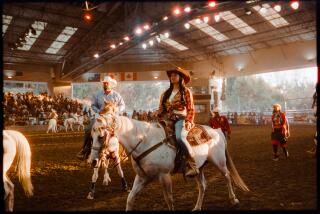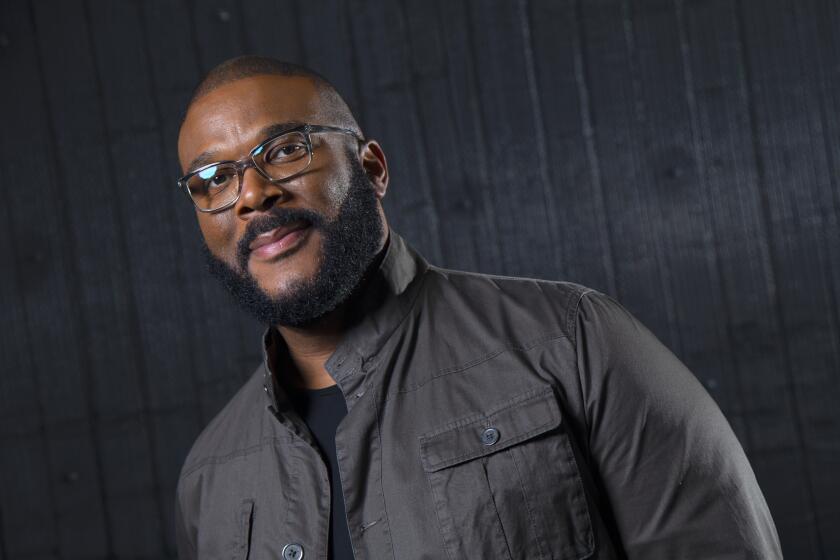Indians’ Captured Images : Artwork reflecting their traditions and encounters with Anglo-American culture will be on exhibit at museum.
- Share via
LOS ANGELES — U.S. history is fraught with confrontations between American Indians and federal government troops. One of the most famous battles pitted the Sioux Indians against Gen. George Custer’s men at Little Big Horn in 1876. Less well-known is the Red River War, the army’s campaign against Southern Plains Indians in 1874.
Unlike the victorious Sioux, the Southern Plains Indian warriors surrendered to the government, which in 1875 exiled and imprisoned without trial a random group of 72 Indian men allegedly responsible for attacking buffalo hunters, troops and civilians. Under the stewardship of Army Capt. Richard H. Pratt, the Indians’ three-year incarceration at Fort Marion in St. Augustine, Fla., was transformed from its original intent--to punish the Indians--into a well-meaning socialization process in the white man’s “civilized” ways.
That effort led almost 30 Indians to produce art, such as drawings in ledger books, reflecting their own traditions and their encounters with Anglo-American culture. Their artwork forms the core of the exhibit, “Beyond the Prison Gate: The Fort Marion Experience and Its Artistic Legacy,” at the Gene Autry Western Heritage Museum.
“The exhibition is designed to generate a sense of empathy for the Indians who were prisoners, and to help you understand what they were going through,” said Michael Duchemin, the Autry Museum’s curator of history. “It identifies the accommodation this group had to make for its own survival.”
Organized by and originally presented at the National Cowboy Hall of Fame in Oklahoma City, “Beyond the Prison Gate” was co-curated by Edwin L. Wade, an authority on American-Indian art, and Arthur Silberman, director of the Native American Painting Reference Library in Oklahoma City. It traveled to the Institute of American Indian Arts in Santa Fe, N.M., before coming to Los Angeles.
The show’s first gallery gives a sense of the life of Southern Plains Indians--Kiowa, Apache, Caddo, Cheyenne, Comanche, Arapaho--before the Red River War. Replicas of tepees and shields made by Vanessa Morgan, a contemporary descendant of the Kiowa, display traditional Indian pictorial art forms.
From the first to the second gallery, there is the “movement from the open plains, a pastoral setting, to a confined life,” Duchemin said.
The events that led to the Indians’ imprisonment began in 1867, when the U.S. government and the Kiowa, Comanche and Apache tribes signed a treaty at Medicine Lodge, in present-day south-central Kansas.
The tribes agreed to cede their vast hunting range in exchange for a reserve of 14,000 square miles in present-day southwest Oklahoma. The Cheyenne and Arapaho agreed to live in a restricted area just north of that reservation.
Trouble began when the “government did not meet its obligations,” Duchemin said. The reservation-bound Indians, whose culture had been based on buffalo hunting, were to be issued government beef rations. But the government did not deliver as promised, and in the spring of 1874, tribes men left the reservation to return to their ancestral hunting grounds.
Some of them attacked hide hunters in Texas who were exterminating buffalo herds. Federal troops responded by destroying Indian camps and food supplies. The Red River War continued through the winter until the destitute Indians surrendered.
Designed with prison-like bars to give the feeling of confinement, the second gallery documents the 3 1/2-week journey the 72 manacled prisoners took by wagon, railroad and steamer from Oklahoma to Fort Marion in Florida. Only one had ever been on a railroad.
“For them, it was like going to another planet,” Duchemin said.
Colored pencil drawings in this gallery display the artists’ awe of the railroad. There is also an area where exhibit visitors can use viewers to see stereoscopic photographs of the Indians at Fort Marion.
The next gallery features several of the stereoscopic viewer cards transformed by laser technology and computer enhancement into large-as-life pictures. By putting on 3-D glasses provided by the museum, visitors can see striking 3-D effects.
The fourth section, “Pratt and the Prisoners,” profiles the Indians’ empathetic warden. He removed their shackles soon after their arrival, put them in army uniforms and developed a program to educate them in the English language, Bible reading, hymn singing and curio production.
“Pratt encouraged them to produce marketable sketches for the increasing number of tourists who visited the prison,” co-curator Wade wrote in an article for Southwest Art magazine.
The next gallery contains drawings such as “Dandies Around Camp” and “Courting” by a Cheyenne Indian, Bear’s Heart. They recall tribal customs practiced before the Indians were forced onto reservations. Howling Wolf, also Cheyenne, depicts tepees, warriors and hunting scenes on a fan. Also in this gallery, there are photographs of individual Indians and text explaining what happened to them after they left Fort Marion.
The final gallery, “Journey’s End, New Beginnings,” presents the work of American-Indian artists who were influenced by the warriors-turned-artists at Fort Marion.
“The artistic record made by these Indian prisoners had direct and explicit links to the long tradition of Plains pictorial art, which had flourished for hundreds of years before the events that culminated in the Red River War,” Wade writes. “For better or worse, they represented the ‘New Indian,’ a mixture of the past and the future . . ., emotionally poised between conservatism and accommodation. They were the first to experience the crisis of identity associated with being modern Native Americans and the first to chronicle the resulting thoughts, quandaries and disillusionments in their art.”
Where and When What: “Beyond the Prison Gate: The Fort Marion Experience and Its Artistic Legacy.” Location: Gene Autry Western Heritage Museum, 4700 Western Heritage Way (next to the zoo), Los Angeles. Hours: 10 a.m. to 5 p.m. daily except Monday. Ends Jan. 9. Price: $6; seniors and students, $4.50; children ages 2 through 12, $2.50. Parking is free. Also: The documentary, “Strangers in Their Own Land” (1993), about contemporary issues facing American Indians in Oklahoma, will be screened at 11:30 a.m. Sunday. Free admission.
More to Read
The biggest entertainment stories
Get our big stories about Hollywood, film, television, music, arts, culture and more right in your inbox as soon as they publish.
You may occasionally receive promotional content from the Los Angeles Times.










